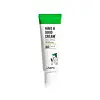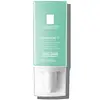What's inside
What's inside
 Key Ingredients
Key Ingredients

 Benefits
Benefits

 Concerns
Concerns

 Ingredients Side-by-side
Ingredients Side-by-side

Water
Skin ConditioningCetyl Ethylhexanoate
EmollientButylene Glycol
HumectantGlycerin
HumectantSqualane
EmollientCentella Asiatica Extract 1.05%
CleansingBacillus Ferment
Skin Conditioning1,2-Hexanediol
Skin ConditioningDicaprylyl Carbonate
EmollientCetearyl Alcohol
EmollientCetearyl Olivate
Trehalose
HumectantArachidyl Alcohol
EmollientDimethicone
EmollientSorbitan Olivate
EmulsifyingArginine
MaskingCarbomer
Emulsion StabilisingPanthenol
Skin ConditioningCaprylyl Glycol
EmollientBehenyl Alcohol
EmollientHydrogenated Lecithin
EmulsifyingArachidyl Glucoside
EmulsifyingSimmondsia Chinensis Seed Oil
EmollientMacadamia Ternifolia Seed Oil
EmollientEthylhexylglycerin
Skin ConditioningAllantoin
Skin ConditioningDimethicone/Vinyl Dimethicone Crosspolymer
Skin ConditioningSodium Hyaluronate
HumectantMentha Haplocalix Extract
MaskingSnail Secretion Filtrate 0.025%
Skin ConditioningMenthyl Lactate
MaskingDisodium EDTA
Backhousia Citriodora Leaf Oil
MaskingPhenoxyethanol
PreservativeAsiaticoside
AntioxidantMadecassic Acid
Skin ConditioningAsiatic Acid
Skin ConditioningBeta-Glucan
Skin ConditioningCitral
PerfumingWater, Cetyl Ethylhexanoate, Butylene Glycol, Glycerin, Squalane, Centella Asiatica Extract 1.05%, Bacillus Ferment, 1,2-Hexanediol, Dicaprylyl Carbonate, Cetearyl Alcohol, Cetearyl Olivate, Trehalose, Arachidyl Alcohol, Dimethicone, Sorbitan Olivate, Arginine, Carbomer, Panthenol, Caprylyl Glycol, Behenyl Alcohol, Hydrogenated Lecithin, Arachidyl Glucoside, Simmondsia Chinensis Seed Oil, Macadamia Ternifolia Seed Oil, Ethylhexylglycerin, Allantoin, Dimethicone/Vinyl Dimethicone Crosspolymer, Sodium Hyaluronate, Mentha Haplocalix Extract, Snail Secretion Filtrate 0.025%, Menthyl Lactate, Disodium EDTA, Backhousia Citriodora Leaf Oil, Phenoxyethanol, Asiaticoside, Madecassic Acid, Asiatic Acid, Beta-Glucan, Citral
Water
Skin ConditioningGlycerin
HumectantIsopropyl Palmitate
EmollientButyrospermum Parkii Butter
Skin ConditioningLauroyl Lysine
Skin ConditioningCetyl Alcohol
EmollientUrea
BufferingPEG-100 Stearate
Glyceryl Stearate
EmollientCera Alba
EmollientPentylene Glycol
Skin ConditioningStearic Acid
CleansingCarbomer
Emulsion StabilisingGlyceryl Acrylate/Acrylic Acid Copolymer
HumectantSodium Hyaluronate
HumectantSodium Hydroxide
BufferingMyristic Acid
CleansingPalmitic Acid
EmollientHydrolyzed Hyaluronic Acid
HumectantCaprylyl Glycol
EmollientCitric Acid
BufferingTrisodium Ethylenediamine Disuccinate
Xanthan Gum
EmulsifyingPolysorbate 60
EmulsifyingPentaerythrityl Tetra-Di-T-Butyl Hydroxyhydrocinnamate
AntioxidantChlorphenesin
AntimicrobialParfum
MaskingWater, Glycerin, Isopropyl Palmitate, Butyrospermum Parkii Butter, Lauroyl Lysine, Cetyl Alcohol, Urea, PEG-100 Stearate, Glyceryl Stearate, Cera Alba, Pentylene Glycol, Stearic Acid, Carbomer, Glyceryl Acrylate/Acrylic Acid Copolymer, Sodium Hyaluronate, Sodium Hydroxide, Myristic Acid, Palmitic Acid, Hydrolyzed Hyaluronic Acid, Caprylyl Glycol, Citric Acid, Trisodium Ethylenediamine Disuccinate, Xanthan Gum, Polysorbate 60, Pentaerythrityl Tetra-Di-T-Butyl Hydroxyhydrocinnamate, Chlorphenesin, Parfum
 Reviews
Reviews

Ingredients Explained
These ingredients are found in both products.
Ingredients higher up in an ingredient list are typically present in a larger amount.
Caprylyl Glycol is a humectant and emollient, meaning it attracts and preserves moisture.
It is a common ingredient in many products, especially those designed to hydrate skin. The primary benefits are retaining moisture, skin softening, and promoting a healthy skin barrier.
Though Caprylyl Glycol is an alcohol derived from fatty acids, it is not the kind that can dry out skin.
This ingredient is also used as a preservative to extend the life of products. It has slight antimicrobial properties.
Learn more about Caprylyl GlycolCarbomer is a polymer of acrylic acid. Its main role is to create a gel consistency.
A high amount of carbomer can cause pilling or balling up of products. Don't worry, most products contain 1% or less of carbomer.
Glycerin is already naturally found in your skin. It helps moisturize and protect your skin.
A study from 2016 found glycerin to be more effective as a humectant than AHAs and hyaluronic acid.
As a humectant, it helps the skin stay hydrated by pulling moisture to your skin. The low molecular weight of glycerin allows it to pull moisture into the deeper layers of your skin.
Hydrated skin improves your skin barrier; Your skin barrier helps protect against irritants and bacteria.
Glycerin has also been found to have antimicrobial and antiviral properties. Due to these properties, glycerin is often used in wound and burn treatments.
In cosmetics, glycerin is usually derived from plants such as soybean or palm. However, it can also be sourced from animals, such as tallow or animal fat.
This ingredient is organic, colorless, odorless, and non-toxic.
Glycerin is the name for this ingredient in American English. British English uses Glycerol/Glycerine.
Learn more about GlycerinSodium Hyaluronate is hyaluronic acid's salt form. It is commonly derived from the sodium salt of hyaluronic acid.
Like hyaluronic acid, it is great at holding water and acts as a humectant. This makes it a great skin hydrating ingredient.
Sodium Hyaluronate is naturally occurring in our bodies and is mostly found in eye fluid and joints.
These are some other common types of Hyaluronic Acid:
Learn more about Sodium HyaluronateWater. It's the most common cosmetic ingredient of all. You'll usually see it at the top of ingredient lists, meaning that it makes up the largest part of the product.
So why is it so popular? Water most often acts as a solvent - this means that it helps dissolve other ingredients into the formulation.
You'll also recognize water as that liquid we all need to stay alive. If you see this, drink a glass of water. Stay hydrated!
Learn more about Water